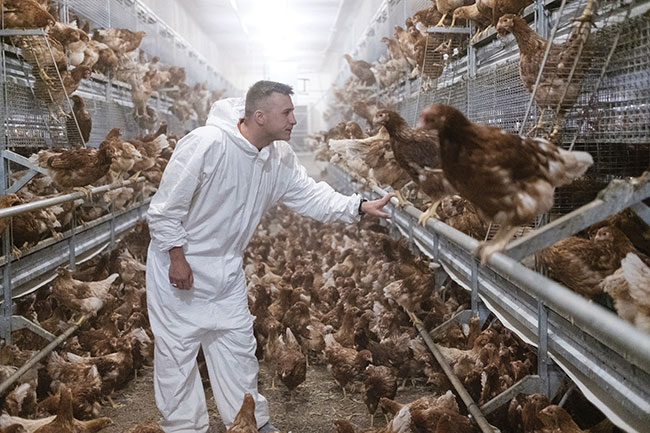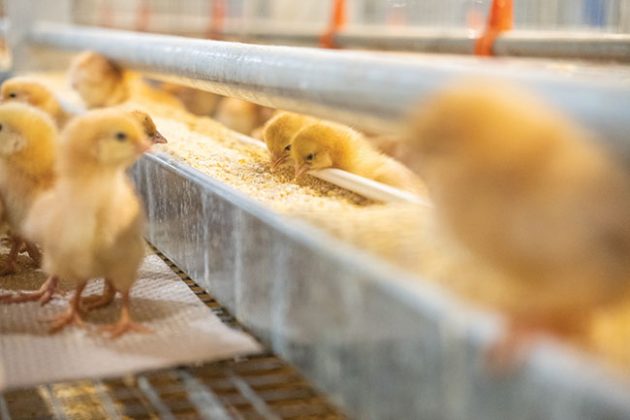
8 tips for operating an aviary
By Ron Wardrop
Features Barn ManagementKey considerations that will have a significant impact.
 Walking the flock is as simple as slowly
walking up and down each litter aisle so your
birds move around.
PHOTO CREDIT: Big Dutchman
Walking the flock is as simple as slowly
walking up and down each litter aisle so your
birds move around.
PHOTO CREDIT: Big Dutchman As we move quickly towards alternative style housing, it’s important to understand how it differs from conventional housing and how to handle those differences. It is also crucial to know how alternative systems are managed, and how to properly deal with the flock within these alternative housing environments. In this article, we look at some best practices for aviary systems.
1. Start the chicks right
It’s best to raise your chicks in an environment that mirrors the laying system that they will be housed in during the lay period. It is a proven fact that birds have a very difficult time learning new behaviours, such as jumping, moving up into the system to drink, feed, perch and lay their eggs in the nest, just to name a few.
The health and performance of your layer flock begins with a good foundation. Starting them in a system that enables your birds to learn the necessary behaviours to thrive as a layer is the key to maximizing your flock’s performance, all the while minimizing management effort. In short, birds that are going into an aviary laying system need to be reared in an aviary rearing system – no exceptions.
2. Train the birds
Chickens are very trainable, and one crucial part of training is during the sunset phase of each day. As the lights dim in the house, it’s important that you train the young chicks to move back into the system for the evening.
After the lights are completely out, you will need to go throughout the barn (with a headlamp) and move any chicks that remain on the floor into the system. After a couple times of doing this, your chicks will start moving back into the system on their own as the lights dim.
With the birds in the system at night, the air movement is able to dry the litter thoroughly and the birds will be encouraged to move and jump throughout the system. Well-trained birds lay almost no floor or system eggs and have superior performance in the layer house.
3. Walk the Flock
Flock movement is another important part of maximizing flock health and performance. One way to promote bird movement is by walking the flock. Walking the flock is as simple as slowly walking up and down each litter aisle so your birds move around. You can also take this time to inspect the birds and the system, ensuring they’re healthy and the system itself is working properly.
We recommend to start walking at random times so the birds do not get used to being moved the same way each day, and start walking your flock as soon as the lights begin to come on. This also offers an opportunity to see floor and system eggs that you must collect immediately. We suggest that you walk the flock five to six times per day.
In addition to walking the flock, we recommend that you spend time every day sitting among the flock. You’d do this to observe the behaviour and temperament of the birds and then adjust as needed. For example, change the light intensity to curb aggression.

It’s best to raise your chicks in an environment that mirrors the laying system that they will be housed in during the lay period.
4. Collect mislaid eggs
Any egg that is laid outside of the nest is considered a mislaid egg and collecting these eggs is critical. If a mislaid egg is left, other birds will be attracted to them, resulting in more mislaid eggs. This will further increase the amount of management time and effort.
By walking your flock and picking up mislaid eggs, your hens will develop what’s called nest acceptance. It’s common to see very high nest acceptance in the range of 98 per cent or higher when the flock is comfortable and walking the litter aisles at least three times per day.
5. Control the lights
Lighting is one of the best management tools offered in an aviary barn. The way the lights are turned on and off will help train and prompt the birds to begin laying and to rest at night.
Using sunrise lighting in the morning and a sunset in the evening encourages natural behaviours and birds will require less management overall. During the sunset phase when your lights begin to dim, you should begin with the lights under the system first. Next, move to the ceiling lights.
Finally, move to the in-system lighting working from the bottom of the system with the top lights being the last to shut off with the end of the sunset. Birds will naturally follow the light and will be encouraged to move off the floor and into the system.
6. Control the egg after it’s laid
Once the egg is laid, it becomes important to make sure it remains high quality. The systems exist on the aviaries to accomplish this if managed correctly. You can program the moving of the belt and the length of the nest box frequently during peak lay periods (this becomes a matter of experimentation that depends on the breeds and barn conditions). This will ensure the eggs are spread out evenly on the egg belt and the eggs do not build up and cause damage to each other due to overcrowded areas along the way.
As well, most aviaries include a programmable egg saver system that stops the egg just before the egg belt, slows the eggs entrance to the egg belt and provides a tool to help control the even distribution of the eggs on the egg belt. Again, this will require some experimentation to work in tandem with the moving of the egg belt. Together when programmed properly these two devices can increase the salable eggs dramatically.
7. Set it up right
Although not a management practice, it is crucial to the long-term success of the facility that some simple barn layout fundamentals are followed. Make sure the aisles are wide enough so that litter remains dry and loose.
If the aisles are too narrow, the litter will remain wet and will clump and stick to the floor. This will discourage birds from dust bathing and require a great deal of effort to control litter throughout the flock. I recommend at least 50 inches of space between sections.
This also becomes important when installing combi systems (systems that can convert from enriched housing to aviary at a later time). If you plan your system with this in mind, your combi system will be a much more effective aviary in the future.
8. Feeding them right
Having a planned feeding program helps establish a routine for the birds and encourages nest acceptance. There are many ideas out there on how many hours you should wait between each feeding, but I think the most important principles to follow are wake the birds up with a feeding and then do not feed them again until after the peak laying period.
Birds are attracted to the sound of the feed system. Thus, they are encouraged to go to the trough when they hear it run and will disturb the use of the nest and cause more mislaid eggs. Once the peak laying period is over, feed the birds at regular intervals throughout the day so that it best suits your situation
If you adopt these simple ideas, your aviary experience will be successful. I know there are many more things that make a successful layer farm, but these I feel are the things that will have the largest impact on a successful aviary operation.
Some equipment manufacturers have bird behavioral specialist on staff to help with the startup and operation of aviary equipment for the novice user. I encourage you to use them to ease the transition and make the aviary experience a success from the very first flock.
Ron Wardrop is regional sales manager, Canada, with Big Dutchman.
Print this page